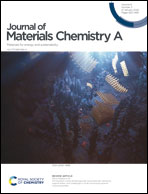Electrochemical in situ construction of vanadium oxide heterostructures with boosted pseudocapacitive charge storage†
Abstract
Pseudocapacitive materials hold extraordinary promise for improving the energy densities of electrochemical capacitors but are often limited to electrodes with ultralow mass loadings (e.g. <1 mg cm−2) due to the sluggish mass transport kinetics in thicker electrodes. Here a V5O12/VO2 heterojunction nanomaterial with a built-in electric field near the heterointerface is fabricated on a 3D graphite substrate via an in situ electrochemical method for the first time, which can remarkably enhance the capacitive performance by improving the electron/ion delivery kinetics. The V5O12/VO2 electrode (mass loading ∼10.8 mg cm−2) achieves a high areal capacitance of 5.03 F cm−2 (465 F g−1) with a good rate capability and long cycle life, outperforming the V5O12 and VO2 counterparts, as well as the state-of-the-art reported VOX electrodes. An asymmetric supercapacitor assembled using V5O12/VO2 as the negative electrode and MnO2 as the positive electrode can deliver high areal/volumetric energy densities of 1.42 mW h cm−2/11.85 mW h cm−3. An extrapolated gravimetric energy density of 18.6 W h kg−1 can also be achieved, based on the entire weight of the device (76.6 mg cm−2, active material ratio ∼30%), representing a critical step of pushing pseudocapacitors toward practical applications.



 Please wait while we load your content...
Please wait while we load your content...